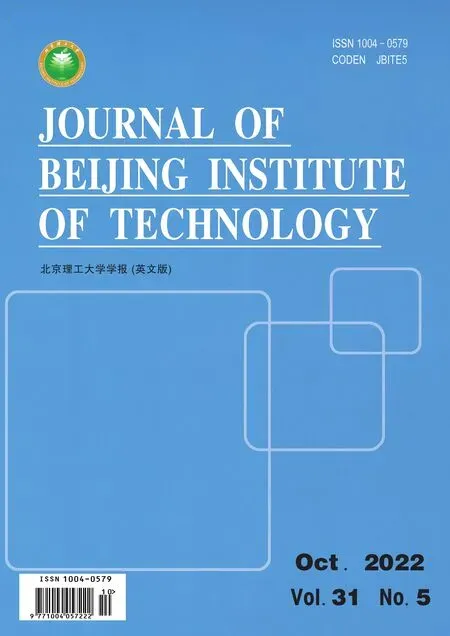Resource Allocation for Uplink CSI Sensing Report in Multi-User WLAN Sensing
2022-11-03YifeiLiJileiYanYanLongXumingFangRongHe
Yifei Li, Jilei Yan, Yan Long, Xuming Fang, Rong He
Abstract: Sensing in wireless local area network (WLAN) gains great interests recently. In this paper we focus on the multi-user WLAN sensing problem under the existing 802.11 standards. Multiple stations perform sensing with the access point and transmit channel state information (CSI)report simultaneously on the basis of uplink-orthogonal frequency division multiple access(OFDMA). Considering the transmission resource consumed in CSI report and the padding wastage in OFDMA based CSI report, we optimize the CSI simplification and uplink resource unit (RU)allocation jointly, aiming to balance the sensing accuracy and padding wastage performances in WLAN sensing. We propose the minimize padding maximize efficiency (MPME) algorithm to solve the problem and evaluate the performance of the proposed algorithm through extensive simulations.Keywords: wireless local area network (WLAN) sensing; channel state information (CSI) simplification; padding wastage; resource allocation
1 Introduction
To provide ambient sensing intelligence, sensing and localization features attract great attentions in beyond the fifth generation of mobile communications technology (B5G) / the sixth generation of mobile communications technology (6G)communication networks [1]. The integrated sensing and communication (ISAC) technology with robust sensing capability is introduced. This technology merges both sensing and communication functionalities over a unified waveform and device, and thus greatly improves the spectrum efficiency and decreases the hardware cost [2].
Besides B5G/6G cellular network, the wireless local area network (WLAN) based on Institute of Electrical and Electronics Engineers(IEEE) 802.11 standards also plays a significant role for user communications due to its ubiquitous and low-cost broadband wireless Internet access [3,4]. With the evolution of WLANs, integrating the sensing services with WLAN communications is also a hot topic recently. The IEEE 802.11bf task group, established in the year of 2020, aims to provide standard for WLAN devices with sensing capability. Under WLAN sensing, the access point (AP) and stations(STAs) in a WLAN could use the WLAN signals to perform sensing for surrounding environments. This enables a wide range of new applications for the future WLANs, such as activities recognition, presence detection, healthcare and target localization both in indoor and outdoor environments [5,6].
One method for WLAN sensing in 802.11bf is based on the channel state information (CSI).Specifically, devices could obtain the CSI information from the received communication frames.The CSI denotes the wireless characteristics of the signal propagation, and thus indicates the full environmental information around transceivers.As a result, devices could extract the sensing result through measuring and analyzing the features of received and reported CSI frames [7].However, there are following two difficulties when implementing the CSI-based sensing in WLANs.
1) CSI simplification for sensing report
According to 802.11ax [8], which is the latest commercial WLAN standard, orthogonal frequency division multiple access (OFDMA) is introduced, where multiple subcarriers are utilized for transmissions. CSI frame denotes the channel state for each subcarrier, and reporting the raw CSI information consumes too much transmission resource. Therefore, rather than transmitting raw CSI directly, the quantization and grouping of CSI is utilized when devices send CSI frames during a CSI reporting phase in WLANs. However, the simplified CSI may cause information loss and decrease sensing accuracy.Hence, the key problem behind such simplification is to balance the performance between sensing accuracy and transmission cost in WLAN sensing.
2) Padding wastage in uplink feedback
When the STAs transmit CSI to AP, they should follow the uplink transmission rules in legacy WLAN standards. According to 802.11ax with OFDMA, all the subcarriers are divided into multiple groups. Each group is referred to as a resource unit (RU), and is allocated to a user based on its transmission requirements and channel conditions. Moreover, to mitigate wireless interference, padding is exploited in 802.11ax when performing OFDMA-based uplink transmissions. Specifically, all the transmissions from multiple STAs inside one OFDMA frame must start and end both simultaneously. To align the ending time, when an STA finishes its data transmission, it should continue to fill null bits(i.e., padding) until the ends of other transmissions. Obviously, this padding is a wastage of resource. Thus, the key problem behind uplink CSI reporting is a proper RU allocation scheme to reduce padding wastage.
The above observations motivate us to study the CSI simplification and resource allocation problems in WLAN sensing. Generally speaking,in this paper, we focus on the CSI based multiuser WLAN sensing problem, where multiple STAs perform sensing with AP and they transmit CSI reporting simultaneously on the basis of uplink-OFDMA.
Through analyzing the size of CSI frame and the OFDMA-based uplink CSI reporting procedure, we optimize the CSI simplification problem and uplink RU allocation problem jointly. To be specific, for the CSI simplification aspect, we optimize the quantization and grouping parameters, which control the CSI frame size and influence the sensing accuracy. Meanwhile, for the resource allocation aspect, the CSI size and RU allocation both determine the padding results and influence the reporting efficiency.
Therefore, we formulate this resource allocation problem in WLAN sensing, through optimizing the quantization /grouping and RU allocation schemes, and balancing the trade-off between sensing accuracy and padding wastage.Moreover, to solve the problem, we propose the minimize padding maximize efficiency (MPME)algorithm to maximize the reporting efficiency and improve the performance of WLAN sensing systems.
2 Related Work
Recently, research on WLAN sensing has gotten more attention. Wu et al. in [9] proposed a Fresnel zone model, which can solve both patternbased and model-based recognition problem. It is a generic model with great potential for devicefree human sensing using fine-grained WLAN CSI. Liu et al. in [10] developed an algorithm that makes use of the channel information in both time and frequency domain to estimate breathing and heart rates. Pu et al. in [11] presented a novel gesture recognition system that leverages wireless signals to enable whole-home sensing and recognition of human gestures. However, these studies mainly focused on the utilization of sensing measurement with WLAN signal,without considering that how the measured sensing data were transmitted under WLANs.
On the other hand, considering the data transmission in WLANs, since the uplink-OFDMA was added to 802.11ax, there have been a lot of studies about it. In a majority of researches, they focused on maximizing transmission rate or throughput with resource allocation.Wang et al. in [12] investigated a novel, divisionbased and resolution-based algorithm to optimally assign users and user groups to subcarriers with the target of maximizing the user sum rate.They also introduced two practical algorithms, a greedy one and a recursive one, which jointly divide the bandwidth into RUs and schedule users on RUs. Specially, Filoso et al. in [13] proposed an innovative RU allocation scheduler comprising a closed-loop feedback controller who can consider both priority and fairness in OFDMA scheduling with the proportional gain.Dutta et al. in [14] focused on minimizing the maximum transmission duration, and came up with a generic framework Min Max Resource Unit Allocation (MMRU-ALLOC) to assign RUs to clients. Karaca et al. in [15] paid attention to the padding problem during scheduling, and proposed a dynamic-presentation protocol data unit(PPDU) algorithm in which the scheduling duration is dynamically confirmed in a resource allocation framework by considering the padding overhead, airtime fairness and energy consumption of the users. Although these works studied the resource allocation under OFDMA, they have not considered the scheduling under sensing scenario, especially integrated with WLAN transmission rules.
3 System Model
3.1 CSI Quantization and Grouping in WLAN Sensing
In this subsection, we mainly introduce the procedure of WLAN sensing defined in 802.11bf. As shown in Fig. 1, the sensing procedure is composed of the following phases: the sensing session setup/termination phases, sensing measurement setup/termination phases and sensing measurement instance phase [16].
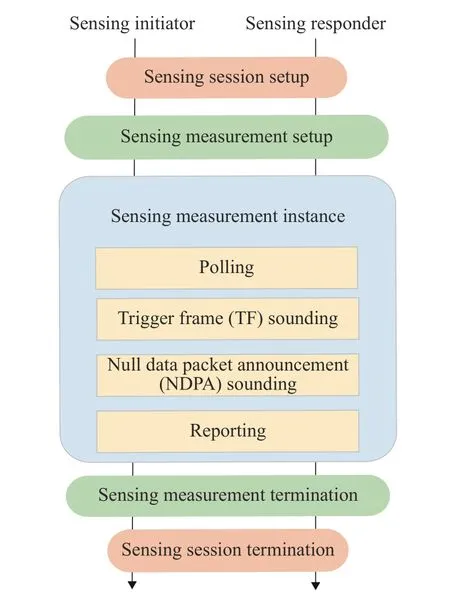
Fig. 1 WLAN sensing procedure
In sensing session setup phase, a sensing session is established between the sensing initiator and responders. The sensing-related capabilities associated with this session are exchanged among AP and STAs. Oppositely, in the sensing session termination, the session established during this phase ends at the scheduled time or when the sensing session termination frame is received.
In sensing measurement setup phase, sensing initiator and sensing responder exchange and negotiate on the operational attributes (e.g.,sensing roles and measurement report types) of sensing measurement instances. This sensing measurement terminates at the scheduled time or when the sensing measurement termination frame is received. When the sensing measurement instances are finished, such termination operation helps to release the resources for storing parameters of the measurement instance.
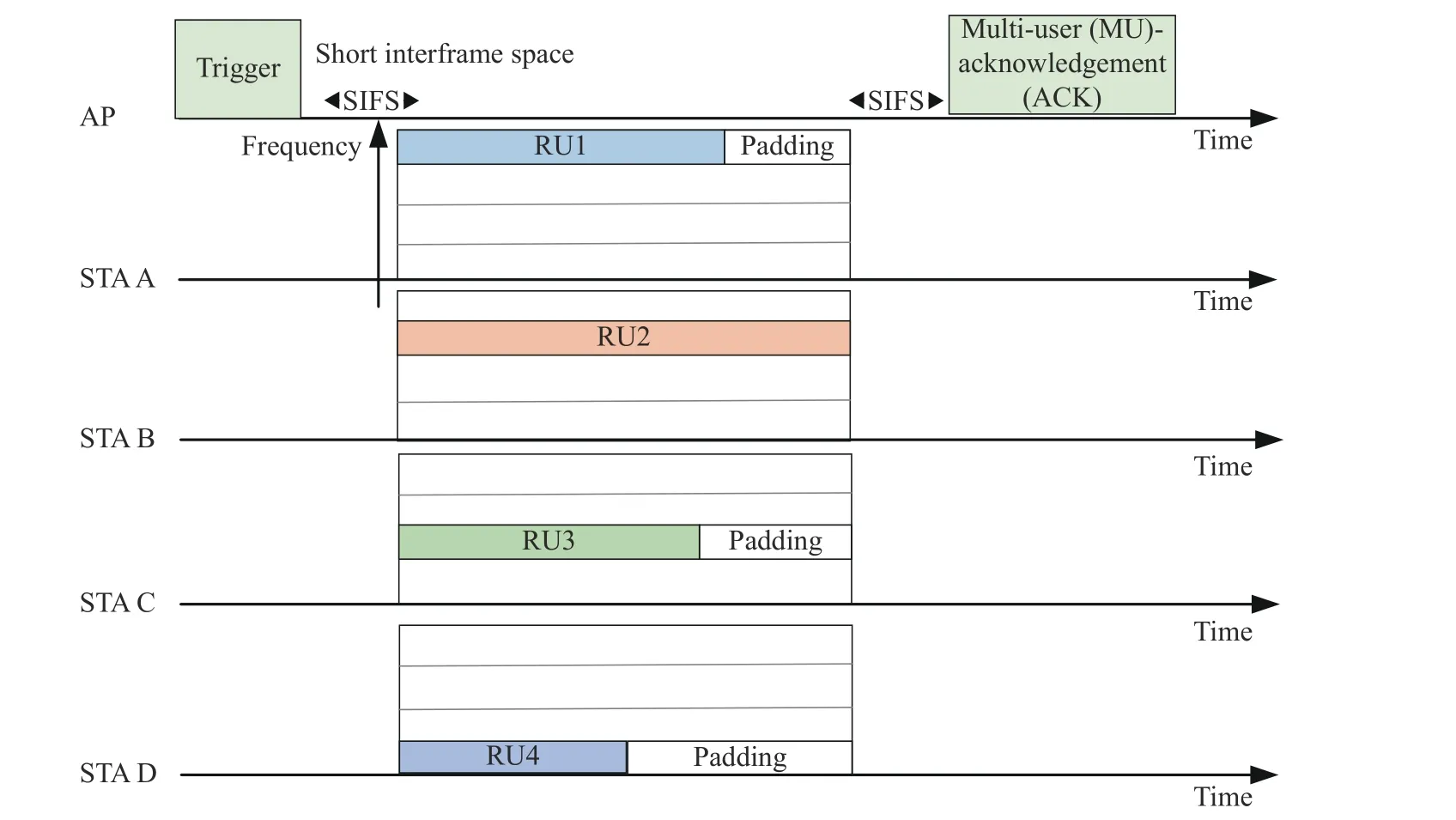
Fig. 2 UL-OFDMA transmission procedure in existing WLANs
In sensing measurement instance phase,sensing initiator and responder perform sensing measurement by transmitting and receiving null data packet (NDP). It includes four subphases:polling, trigger frame (TF) sounding, null data packet announcement (NDPA) sounding and reporting. In polling subphase, AP confirms the availability of STAs for sensing sounding. In TF sounding subphase, AP transmits a TF, and the STA responds an NDP to AP for CSI measurement. Similarly, in NDPA sounding subphase,AP transmits an NDPA frame and an NDP to measure CSI. Finally, in reporting subphase,STAs report CSI frame and AP performs sensing measurement based on the CSI frame. According to the 802.11ax, when an AP performs sensing measurement with multiple STAs at the same time, these STAs will report CSI frames to AP simultaneously through the OFDMA-based uplink transmissions.
The detail of CSI frame is first given in 802.11n [17], and 802.11ax also follows this regulation. According to the definition in 802.11n,Fig. 2 illustrates the detail format of CSI report field in a CSI frame.
As shown in Tab. 1, the data size of CSI matrix for a subcarrier is

whereNbdenotes the number of bits of quantized CSI. In-phase and quadrature components of each element in the CSI matrix are scaled and quantified toNbbits. The value ofNbis different under various quantization methods, and the typical values are 4, 5, 6 and 8.Ncis the number of transmitter antennas andNris the number of receiver antennas. Moreover, as mentioned in 802.11n standard [17], 2 represents the in-phase and quadrature components and the carrier matrix amplitude is 3 bits. Furthermore, since CSI is measured over each subcarrier under OFDMA mode, the size of CSI information is large due to a great many subcarriers. To reduce the CSI transmission cost, CSI matrix grouping method is adopted through grouping the CSI information over multiple adjacent subcarriers.That is, eachNgadjacent subcarriers become a group and each group reports only one CSI matrix.Ngis the number of carriers grouped into one.
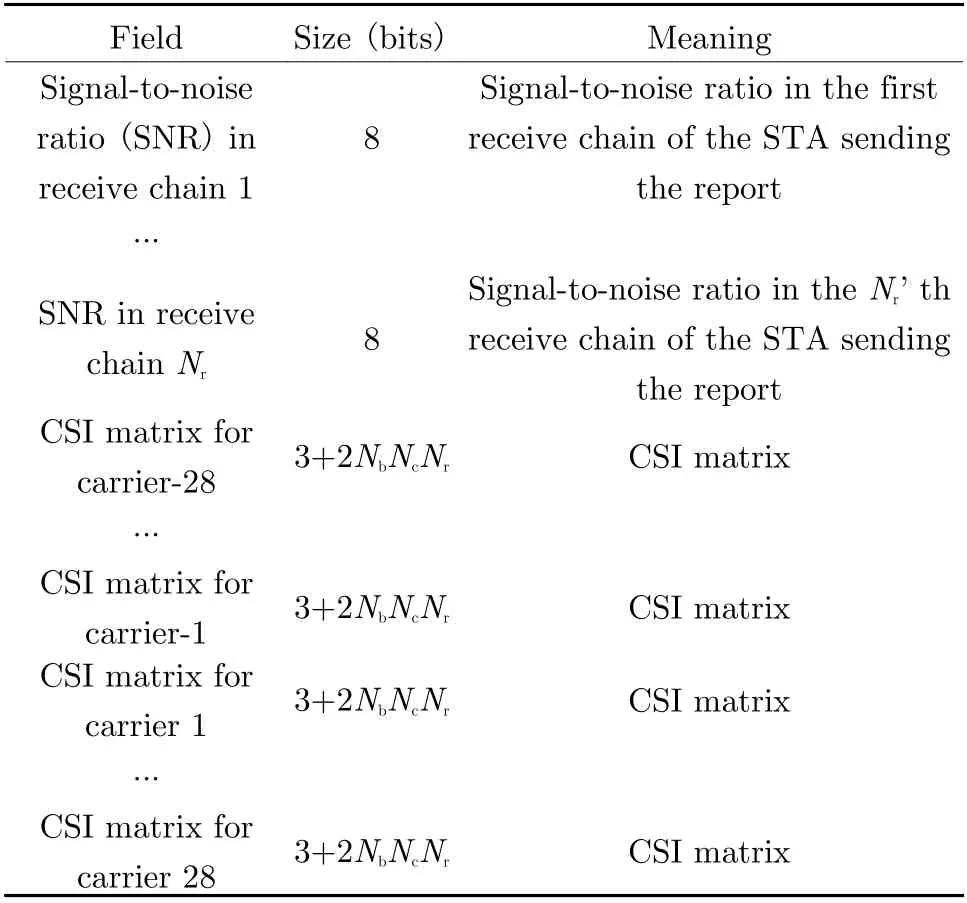
Tab. 1 Number of matrices and carrier grouping
As a result, the size of the CSI report field can be calculated as

whereNsis the total number of the groups. The relationship betweenNsandNgis shown in Tab. 2. In summary, the size of CSI frame can be changed base on the value ofNbandNg, and utilizing CSI quantization and grouping makes the sensing reporting more flexible.
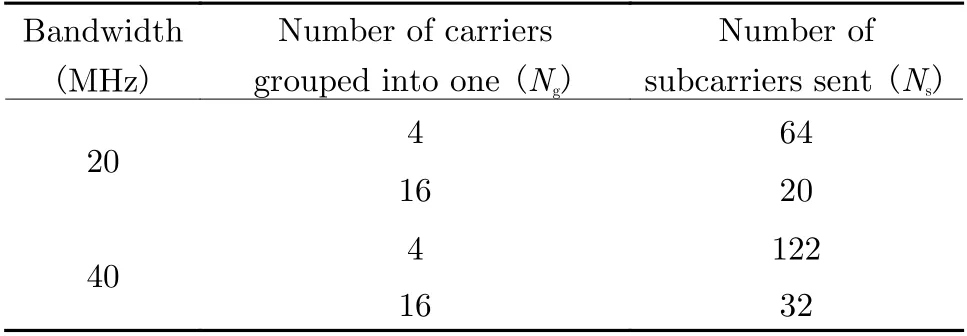
Tab. 2 Number of matrices and carrier grouping
3.2 OFDMA-Based Multi-User Uplink CSI Feedback
In this subsection, we briefly summarize the main characteristics of multi-user (MU) transmission in 802.11ax. In comparison with previous standards, 802.11ax expands the multi-user capabilities through exploiting OFDMA transmissions.The AP allocates the RU (i.e., a set of subcarriers) to an STA for its uplink (UL) transmission.Ranging from 26 tones (26 subcarriers) to 2×996 tones, the size of an RU depends on the specific spectrum bandwidth in WLANs.
Meanwhile, in order to avoid interference among overlapping basic service sets (OBSSs)and keep low-complexity synchronization design in WLANs, 802.11ax requires that multiple STAs under UL-OFDMA transmissions should obey the same scheduling duration that they should start/end their transmissions at the same time.To this end, the STAs with insufficient data will fill in the duration by transmitting padding bits.This padding in return results in the transmission efficiency reduction due to the wastage on transmission energy, spectrum and time resources.
Fig. 2 depicts the UL-OFDMA transmission procedure in existing WLANs. Assume channel bandwidth is 20 MHz. There are totally 4 RUs,and each RU contains 52 tones. The AP schedules the UL transmissions among STAs via a trigger frame. The trigger frame indicates the start of following UL transmissions phase and instructs the RUs allocation information for STAs. It can be found that all the transmissions align their end time, and the A, C and D STAs fill in different sizes of padding bits after finishing their data transmissions.
3.3 Resource Allocation Problem Formulation
From the analysis above, we can observe that the length of padding is directly impacted by the data size of transmission packets and the RU allocation results.
Furthermore, the packet data size is decided by the CSI reporting frame in WLAN sensing,which is related to the quantization and grouping parameters in subsection 3.1. Then the CSI is transmitted over UL-OFDMA with RUs, which is allocated in subsection 3.2. As a result, we optimize these two aspects in this subsection.The CSI simplification problem and uplink RU allocation problem are considered together. To balance the performance between sensing accuracy and padding wastage, we pursue the reporting efficiency maximization, under the constraints of padding wastage and transmission rate.The details of the resource allocation problem formulation in WLAN sensing are as follows.
For a multi-user WLAN sensing scenario,the number of STAs isn, and each STA has different signal-to-noise ratio (SNR)S={s1,s2,...,sn}. According ton, the set of RUs isR={r1,r2,...,rn}. We refer toθi,ras an RU allocation parameter, whereθi,r ∈{0,1}.When STAiis allocated to RUr,θi,r=1, elseθi,r=0. Based on the Shannon’s formula, we have

wherevi,ris the transmission rate of STAiover RUr.Brrepresents the bandwidth of RUr, andsi,ris the SNR of STAiover RUr. The transmission rate of STAivaries with the assigned RU.
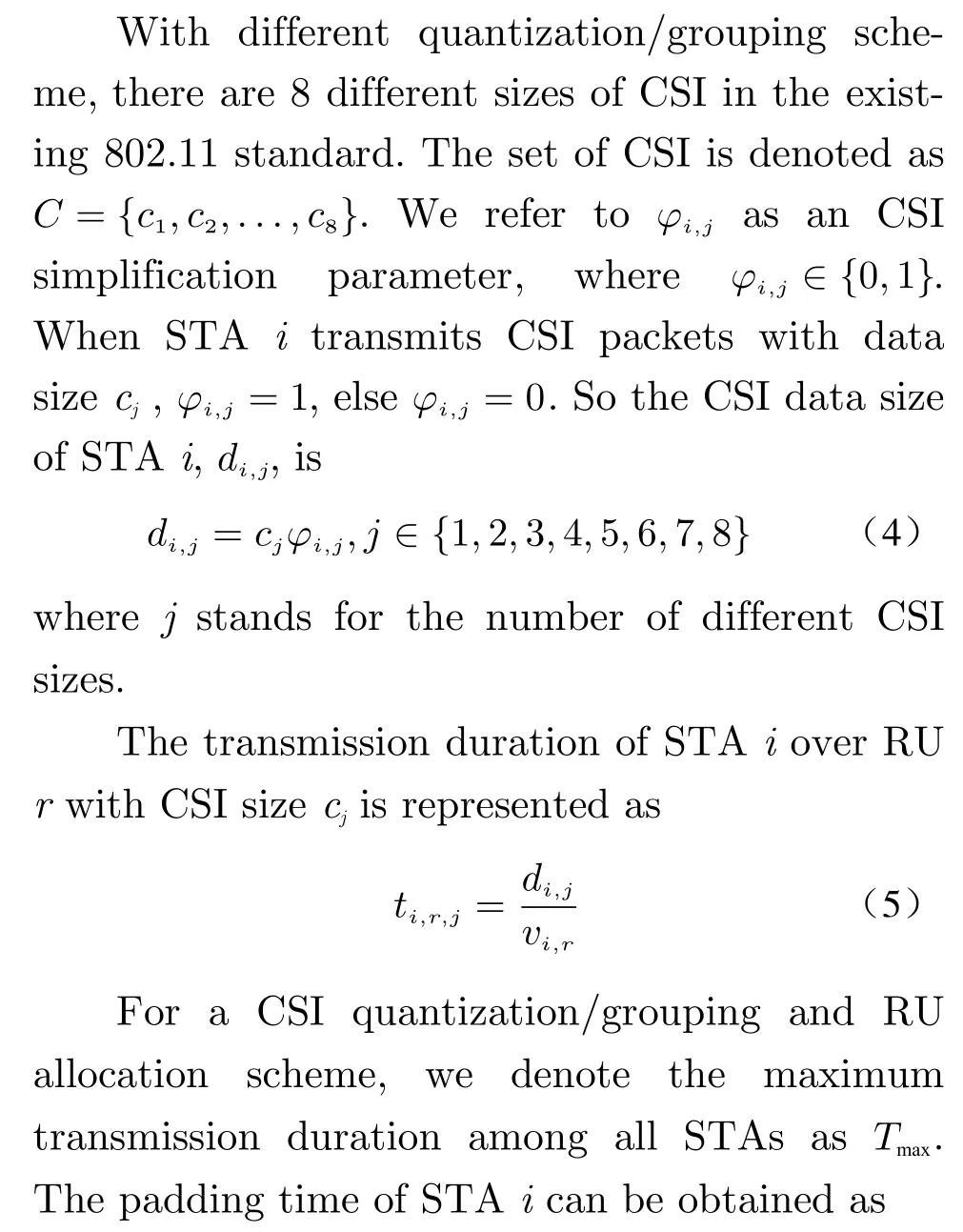
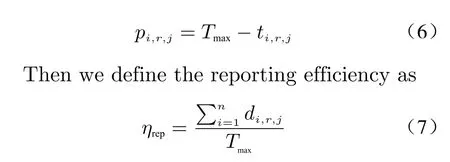
wherenrepresents the total number of STAs,di,r,jrepresents the transmitted data size when STAiis assigned to transmit a CSI packet of size numberjon RUr, which reflects the balance between sensing accuracy and padding wastage. To be specific, the molecule represents the size of transmitted CSI packets, and thus reflects the sensing accuracy. The denominator represents the transmission duration. It consists of two parts, the actual transmission duration and the padding time, and thus reflects the padding wastage.
To maximize the reporting efficiency, we could increase the transmitted CSI data size (i.e.,the molecule) and meanwhile decrease the transmission duration (i.e., the denominator). To decrease the transmission duration, the total padding time should not exceed the padding wastage constraint. That is
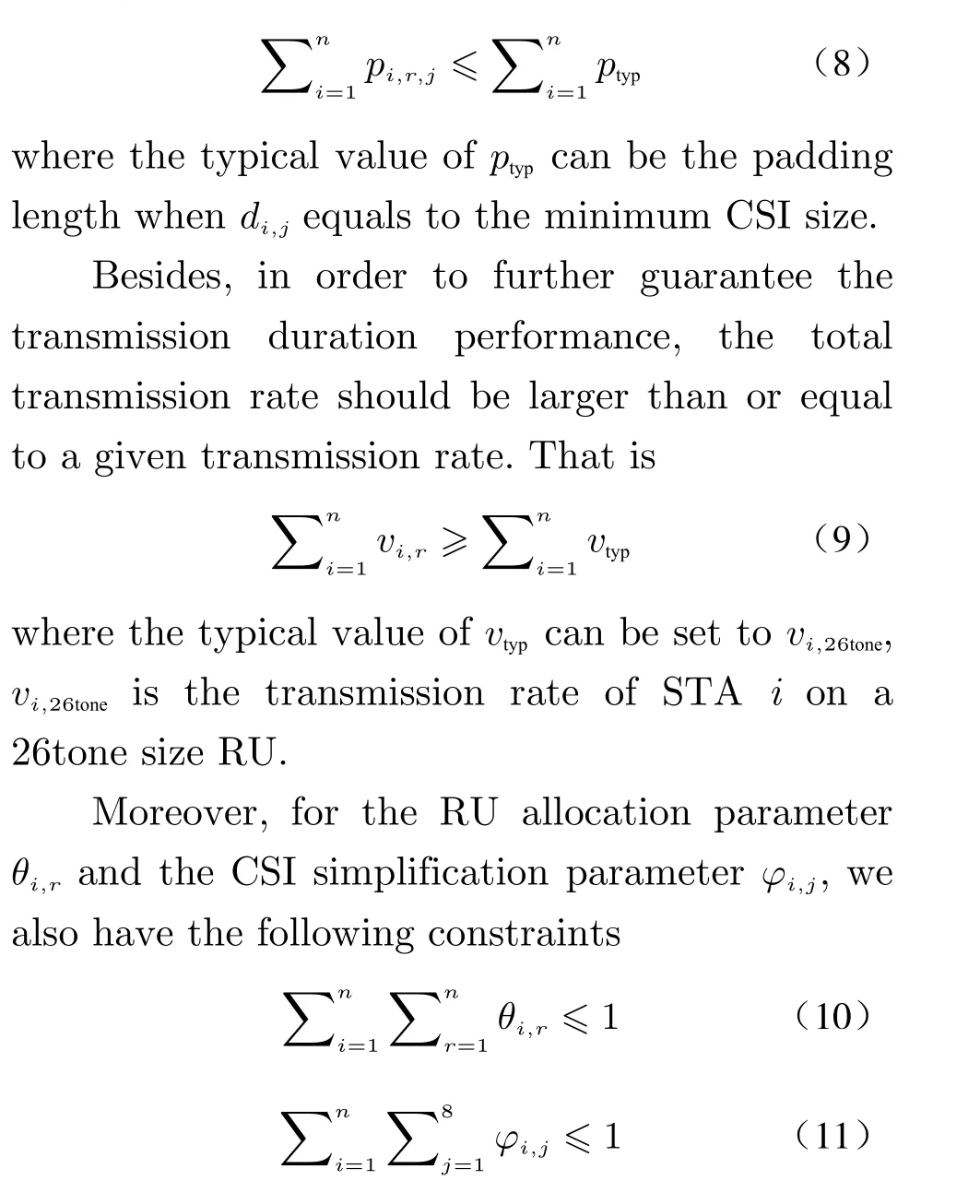
Overall, we can formulate this resource allocation problem in WLAN sensing as
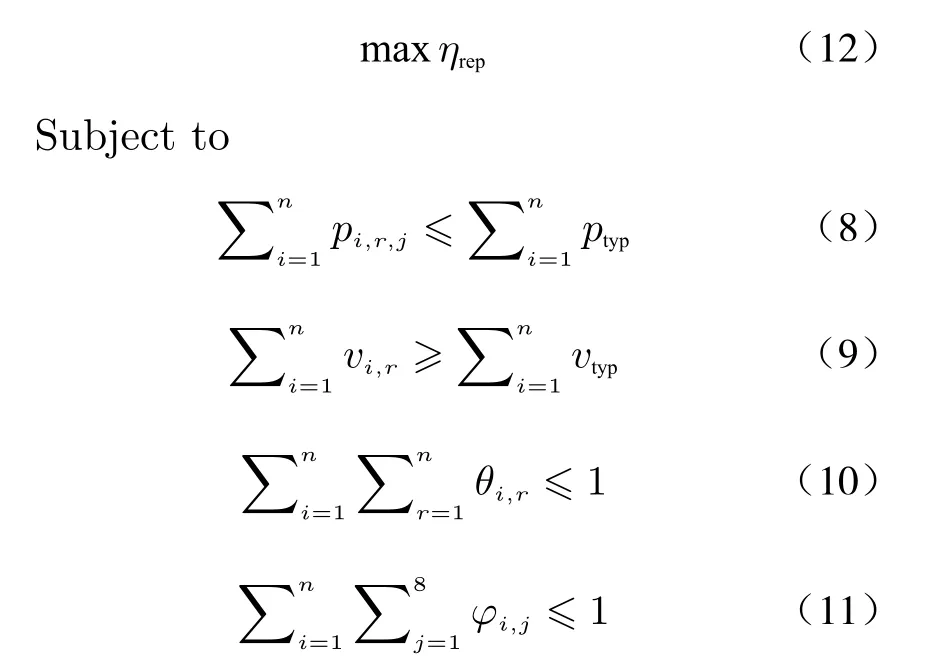
To solve this problem, and obtain the CSI quantization/grouping and RU assignment schemes for STAs, we design the MPME algorithm in the next section.
4 MPME Algorithm
In the proposed MPME algorithm, we try to solve the above optimization problem in two procedures. The first procedure is to satisfy the constraint (9), and we allocate RUs to maximize the total transmission rate of STAs in a greedy way.The second procedure is to satisfy the constraint(8), and we match the appropriate simplified CSI size for each STA according to the corresponding transmission rate derived in the first procedure.
4.1 RU Allocation for STAs
In the first procedure, the bandwidth, the number of STAs, the SNR of each STA, and RU combinations are given. In the practical applications, the transmission rate of STAs is indicated by the modulation and coding scheme (MCS)value instead ofvi,rin (3). Thus, for STAiover RUr, we compare thesi,rwith the minimum sensitivity requirement of each MCS. Only whensi,ris larger than the minimum sensitivity requirement, such MCS can be used for the transmission of STAiover RUr. Among all the satisfied MCS values, we choose the maximum available MCS value, which refers to the maximum transmission rate of STAiover RUr.
Through the above processes, the transmission rate matrix for each STA on different RU can be derived. Considering that each STA must be allocated with only one RU, and each RU can only be allocated to at most one STA, we pick the maximum value from this matrix, and cancel the corresponding STA and RU from this matrix.We continue to select the maximum transmission rate of the remaining STAs and RUs in this matrix. Repeat these steps until all STAs are assigned with RUs. In this way, each STA is allocated with an RU, and its corresponding transmission rate is relatively large.
4.2 CSI Simplification for Each STA
In the second procedure, we match STAs with proper simplified CSI data size. We form a transmission duration matrix for each STA with different CSI sizes according to the transmission rate results derived in the first procedure. The goal is to find out a combination from this matrix with the minimal duration differences(i.e., padding).
To this end, first, we fix CSI data sizec1for STA 1, and compare its transmission duration value with other STAs. We choose the CSI size for other STAs with the minimal transmission duration difference compared with that of STA 1.In this way, we get a combination of transmission duration on the basis of STA 1 andc1. Next,we fix CSI sizec2for STA 1. We repeat the above procedure and get another transmission duration combination based on STA 1 andc2.Since there are 8 kinds of CSI sizes, overall, we get 8 combinations.
For each combination, we could calculate its report efficiency based on (7). Therefore, to maximize the report efficiency, i.e., the objective function, we choose the combination with the maximal report efficiency. In this way, finally, we could determine the appropriate RU allocation and CSI simplification results for STAs.
Overall, the detail of MPME algorithm is shown in Algorithm 1.
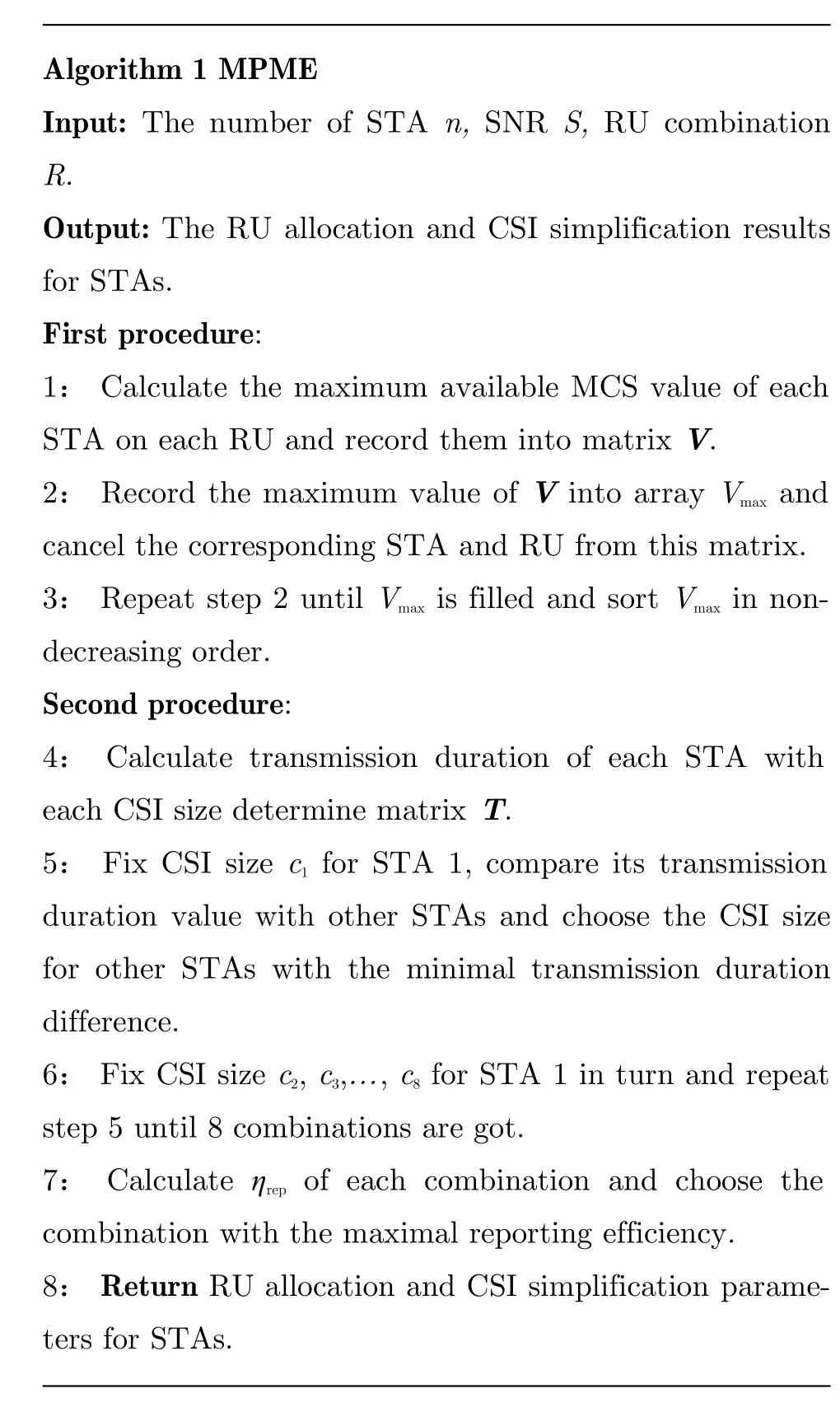
Algorithm 1 MPME Input: The number of STA n, SNR S, RU combination R.Output: The RU allocation and CSI simplification results for STAs.First procedure:1: Calculate the maximum available MCS value of each STA on each RU and record them into matrix V.2: Record the maximum value of V into array Vmax and cancel the corresponding STA and RU from this matrix.3: Repeat step 2 until Vmax is filled and sort Vmax in nondecreasing order.Second procedure:4: Calculate transmission duration of each STA with each CSI size determine matrix T.5: Fix CSI size c1 for STA 1, compare its transmission duration value with As wit other STAs and choose the CSI size for other STh the minimal transmission duration difference.6: Fix CSI size c2, c3,…, c8 for STA 1 in turn and repeat step 5 until 8 combinations are got.7: Calculate ηrep of each combination and choose the combination with the maximal reporting efficiency.8: Return RU allocation and CSI simplification parameters for STAs.
5 Simulation
5.1 CSI Feedback Efficiency
To verify the performance of MPME algorithm with different numbers of STAs, we simulate it simultaneously with four other allocation methods and plot the results by taking 1 000 times averages.
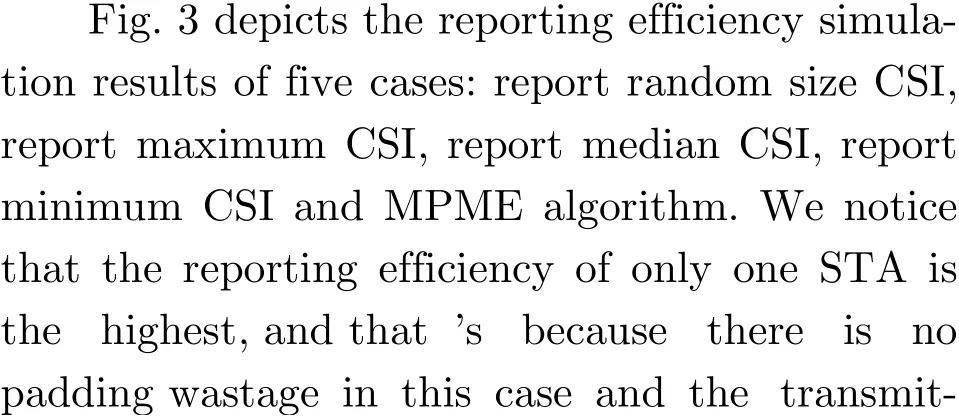
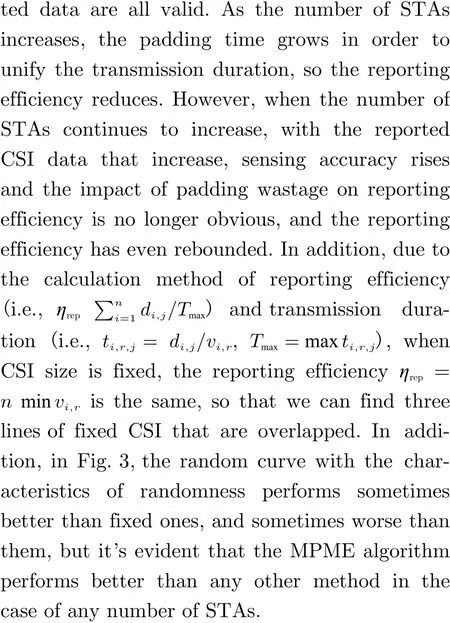
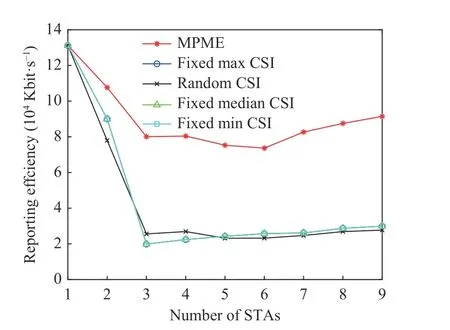
Fig. 3 Reporting efficiency under 20 MHz
In the situation under the channel bandwidth of 40 MHz, more STAs are assigned at the same time. As shown in Fig. 4, compared with the figure at the channel bandwidth of 20 MHz,the reporting efficiency rebounds more obviously because the number of STAs is larger, and the total amount of transmitted data and the valid data is grown more. Compared with padding wastage, the improvement of sensing accuracy has a greater effect on reporting efficiency.
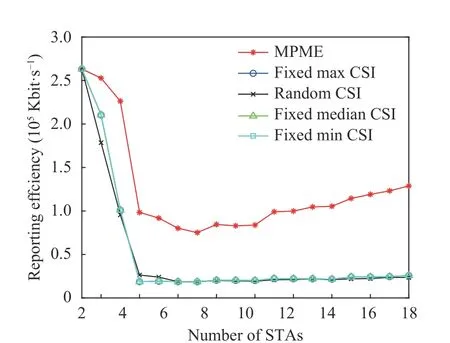
Fig. 4 Reporting efficiency under 40 MHz
5.2 Average Padding Time
Fig. 5 illustrates average padding times under the same five cases. When the number of STA is one,there is no padding, so all curves start at 0. As the number of STAs increases, the average padding time rises due to matching the transmission duration of multiple STAs. And the larger the data size is, the longer the required transmission duration and the padding time will be.Among these five curves, the random curve is similar to the medium-sized curve due to its randomness, and the MPME curve is the most stable one with the least padding time due to its reasonable allocation.
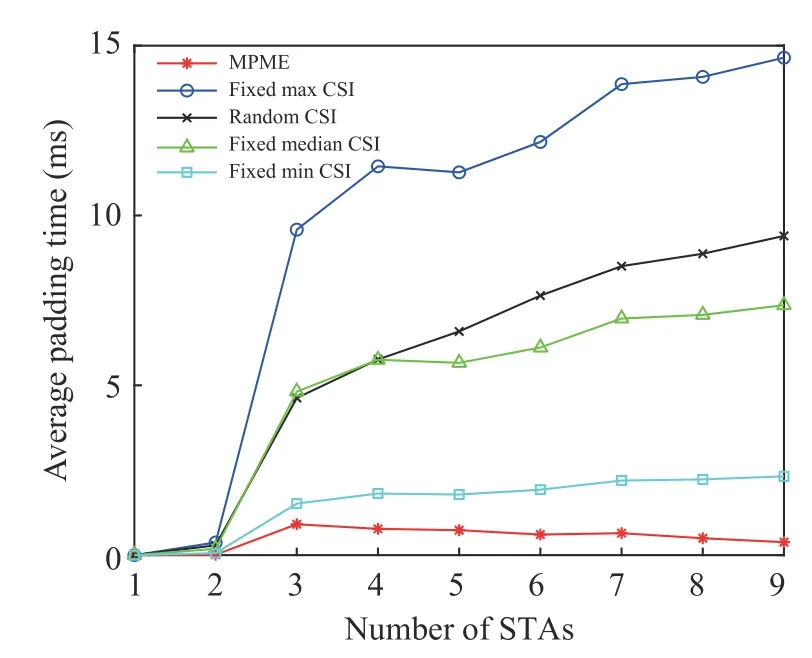
Fig. 5 Average padding time under 20 MHz
Then observing Fig. 6, unlike under the channel bandwidth of 20 MHz, there exists the decrease in average padding time with an increase in the number of STAs. That may because, when the number of STAs increases, the allocated RU size is more similar, so that the transmission duration of STAs is closer. However,the total transmission duration is also longer, so it can be found in the reporting efficiency curve that shows although the padding time decreases,the reporting efficiency doesn’t increase.
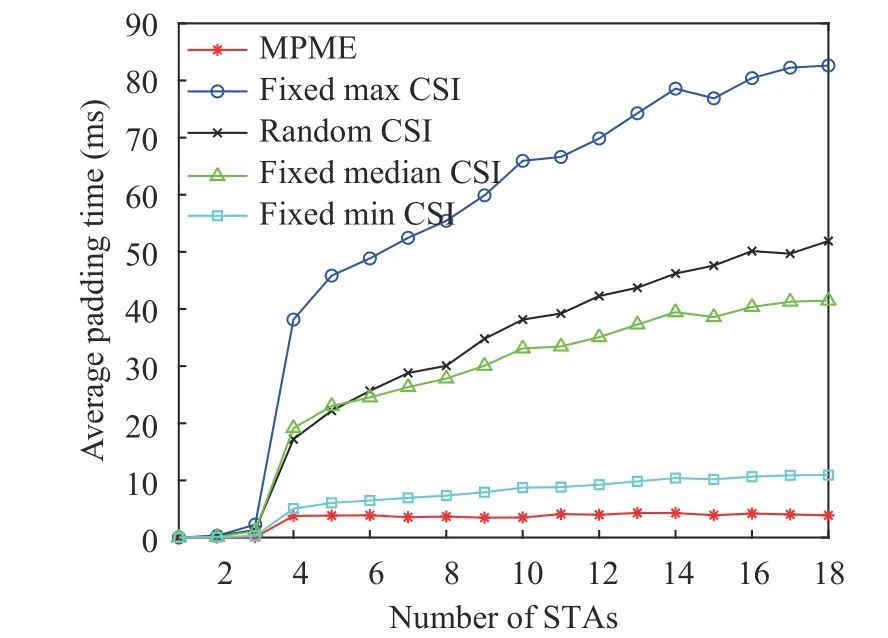
Fig. 6 Average padding time under 40 MHz
6 Conclusion
In this paper, we have discussed the resource allocation problem in WLAN sensing through optimizing the CSI simplification and uplink RU allocation jointly. We provided the MPME algorithm which can improve the padding wastage and sensing accuracy performances concurrently,and maximize the reporting efficiency during uplink CSI sensing report. We implemented this MPME algorithm and evaluated its performance.We noticed that this algorithm has a significant reduction in padding and improvement in reporting efficiency compared with other methods, and also performs more stably. This MPME algorithm can be an effective solution to the problem raised in this paper, and further research will be carried out in the future.
杂志排行
Journal of Beijing Institute of Technology的其它文章
- A Multi-Vehicle Cooperative Localization Method Based on Belief Propagation in Satellite Denied Environment
- Optimization and Design of Cloud-Edge-End Collaboration Computing for Autonomous Robot Control Using 5G and Beyond
- Optimize the Deployment and Integration for Multicast-Oriented Virtual Network Function Tree
- Performance Analysis for Mobility Management of Dual Connectivity in HetNet
- Symbol Synchronization of Single-Carrier Signal with Ultra-Low Oversampling Rate Based on Polyphase Filter
- Intelligent Reflecting Surface with Power Splitting Aided Symbiotic Radio Networks
